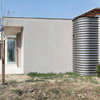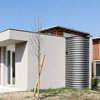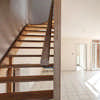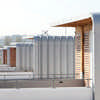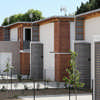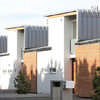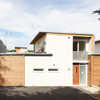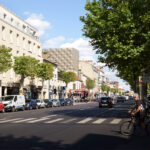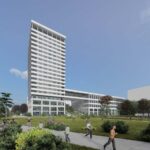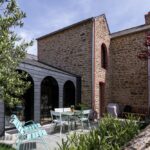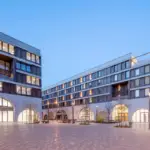Les Platanes, French Housing units for Travellers, France Development, Architect
Les Platanes : Housing in Saint-Genis-Laval
French Residential Buildings – design by Jacky Suchail Architectes
14 Jun 2013
Les Platanes
Design: Jacky Suchail Architectes
Location: France
Les Platanes – 18 housing units for travellers in Saint-Genis-Laval
Another way of living
A permanent home
Saint-Genis-Laval is situated in the south-west of the Lyon conurbation. Its increasing attractiveness, and the way it has developed since the 1950s, go hand in hand with a dynamic, innovative social housing policy.
The purpose of Les Platanes is to provide accommodation for travellers who have been sedentary for the last thirty years, but whose living conditions, in terms of health and safety, are precarious.
The community of travellers has been experiencing radical changes. And this project, both in its design and its urban character, comprises a subtle equilibrium of collective considerations and private life, in a spirit of receptiveness and attention to human needs.
The viewpoint of Catherine Leseigneur, director of operations at Grand Lyon Habitat
Les Platanes is the first operation of its kind to be carried out by the commissioning body, Grand Lyon Habitat, on land belonging to the local authority. The gestation period was lengthy, given that the needs of the future residents had to be reconciled with local regulations regarding provisions made for travellers. Grand Lyon Habitat took an ongoing interest in the project, in keeping with its convictions and its strategy as a provider of social housing.
What the future residents wanted, apart from accommodation as such, was a number of associated services. During the planning phase, discussions and joint site visits took place which brought to light some sources of uneasiness, but also the idea of shared responsibility. Moving into a new home signified a radical change for people who were becoming tenants for the first time.
The general approach was relatively close to the traditional model. No specific preference was expressed, apart from the provision of a parking place for a caravan behind the garage. Simplicity and amenity were the priorities.
For the residents of the 18 units, community life presented certain contradictions, e.g. the close proximity of family members who also needed their own personal spaces – “together, but separately”.
There was a general feeling of satisfaction, but also one of cultural change, with the loss of customs and traditions that had formed these people’s identity. The misgivings they expressed were highly unusual: too much silence, too much natural light, two-storey dwellings, bedrooms too far away – too much room!
For Grand Lyon Habitat, this was an unusual and stimulating project, giving a unique opportunity to consult the future occupants as joint decision-makers.
An urban typology: the hacienda
The complex consists of 18 units in 2 parallel rows, facing, respectively, east and west. Its “hacienda” aspect derives from the fact that it forms a single totality, around a central space closed in by walls on the north and south sides.
The houses all have gardens in the central space. And the difference of level between the 2 rows accentuates the inner volume of this enclosed complex.
On the other side, between the street and the houses, there is an intermediate area that is partly planted out and partly paved. The houses are all south-facing, which means that people’s living rooms do not face each other.
A different lifestyle
Les Platanes is the first project in the Rhône-Alpes region to provide travellers with a conventional form of housing rather than the more usual alternative of annexes added to caravans on their sites.
The ground plan is simple and clear, based on the users’ requirements in terms of natural light, acoustics and thermal properties. There are 3- and 4-roomed units, suitable for young couples setting up house early in life. Most of the units are 2-storeyed. But there are also 3 one-storey units with 3 rooms each, for elderly people and those of reduced mobility.
The 2-storey units have the kitchen, living room and garage on the ground floor. On the upper floor there are the bedrooms and bathroom, along with a roof terrace. The ribbed steel roof coverings fold over the north-facing walls. The 4-roomed units have an extra bedroom that gives access to the terrace.
The single-storey units have larger floor plans, with outward-facing corner windows, on concrete slabs juxtaposing lawns. This continuity marks their relationship to the ground.
The style is classical, complemented by a number of environmental provisions. The concrete structure has an inorganic coating on the outside, and a layer of insulation on the inside. The roof terraces are planted out, and the steel roof coverings have wood frames, along with solar panels to provide hot water, and tanks to store rainwater.
Form and substance
The architectural inspiration for Les Platanes derives from the metaphorical influences and symbolic images that have shaped the agency’s ethos:
• the harmony and complementarity of shapes and materials, the light-heavy contrast being represented by that of concrete versus wood and steel;
• the base constituted by the terrace roofs, which also gives horizontality to the gradient of the site;
• the regular pattern of the single-slope roofs and the cylindrical rainwater storage tanks;
• the composition and design of the houses, and the complex as a whole.
Les Platanes : Housing in Saint-Genis-Laval images / information from Jacky Suchail Architectes
Location: Saint-Genis-Laval, France
New Buildings in France
French Architectural Projects
French Architecture Offices – design firm listings
Paris Architecture Walking Tours by e-architect
Southern French Architecture
Mozart ZAC Housing, Lyon
Design: Tectoniques
Mozart ZAC Housing
DI-VA house, Lyon, southern France
Design: Tectoniques
House in Lyon
Buildings / photos for the Les Platanes / French Housing for Travellers – Saint-Genis-Laval Architecture page welcome
Website: Saint-Genis-Laval France

